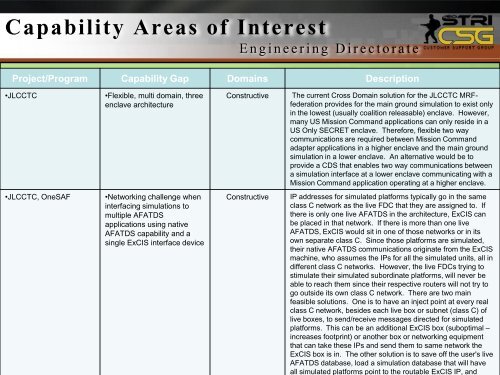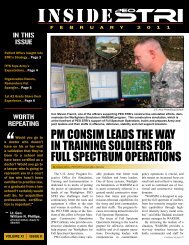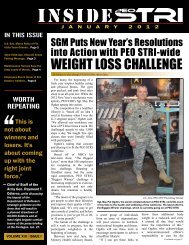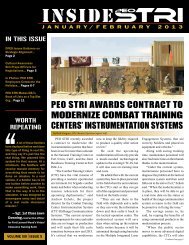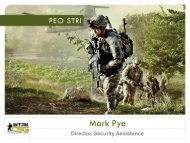TILO: Capability Areas of Interest - PEO STRI
TILO: Capability Areas of Interest - PEO STRI
TILO: Capability Areas of Interest - PEO STRI
Create successful ePaper yourself
Turn your PDF publications into a flip-book with our unique Google optimized e-Paper software.
<strong>Capability</strong> <strong>Areas</strong> <strong>of</strong> <strong>Interest</strong><br />
E n g i n e e r i n g D i r e c t o r a t e<br />
Project/Program <strong>Capability</strong> Gap Domains Description<br />
•JLCCTC<br />
•Flexible, multi domain, three<br />
enclave architecture<br />
Constructive<br />
The current Cross Domain solution for the JLCCTC MRFfederation<br />
provides for the main ground simulation to exist only<br />
in the lowest (usually coalition releasable) enclave. However,<br />
many US Mission Command applications can only reside in a<br />
US Only SECRET enclave. Therefore, flexible two way<br />
communications are required between Mission Command<br />
adapter applications in a higher enclave and the main ground<br />
simulation in a lower enclave. An alternative would be to<br />
provide a CDS that enables two way communications between<br />
a simulation interface at a lower enclave communicating with a<br />
Mission Command application operating at a higher enclave.<br />
•JLCCTC, OneSAF<br />
•Networking challenge when<br />
interfacing simulations to<br />
multiple AFATDS<br />
applications using native<br />
AFATDS capability and a<br />
single ExCIS interface device<br />
Constructive<br />
IP addresses for simulated platforms typically go in the same<br />
class C network as the live FDC that they are assigned to. If<br />
there is only one live AFATDS in the architecture, ExCIS can<br />
be placed in that network. If there is more than one live<br />
AFATDS, ExCIS would sit in one <strong>of</strong> those networks or in its<br />
own separate class C. Since those platforms are simulated,<br />
their native AFATDS communications originate from the ExCIS<br />
machine, who assumes the IPs for all the simulated units, all in<br />
different class C networks. However, the live FDCs trying to<br />
stimulate their simulated subordinate platforms, will never be<br />
able to reach them since their respective routers will not try to<br />
go outside its own class C network. There are two main<br />
feasible solutions. One is to have an inject point at every real<br />
class C network, besides each live box or subnet (class C) <strong>of</strong><br />
live boxes, to send/receive messages directed for simulated<br />
platforms. This can be an additional ExCIS box (suboptimal –<br />
increases footprint) or another box or networking equipment<br />
that can take these IPs and send them to same network the<br />
ExCIS box is in. The other solution is to save <strong>of</strong>f the user's live<br />
11<br />
AFATDS database, load a simulation database that will have<br />
all simulated platforms point to the routable ExCIS IP, and


